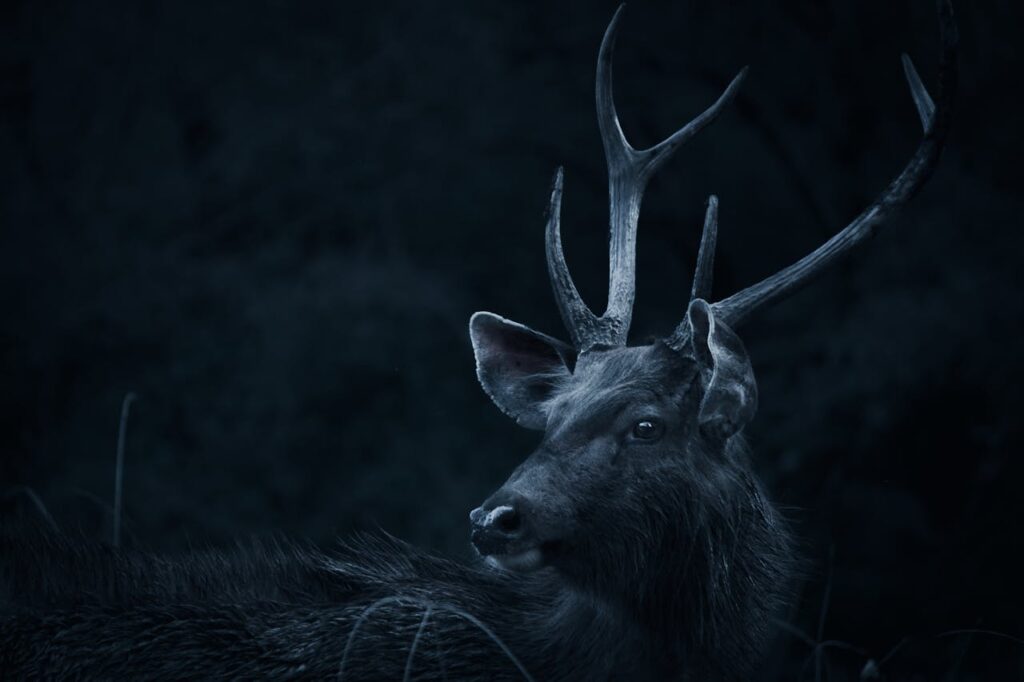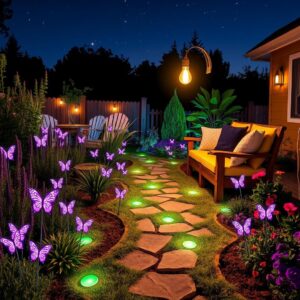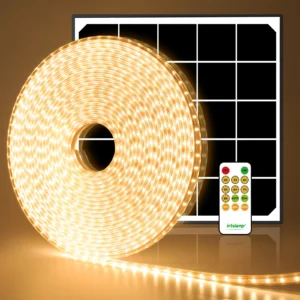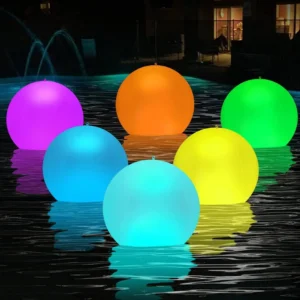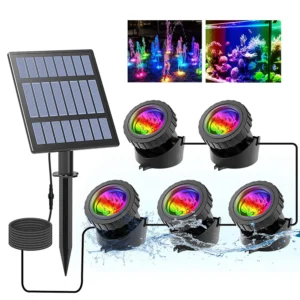Lights play a crucial role in influencing animal behavior and ecology. This article explores how solar lights affect wildlife, considering both their potential as animal deterrents and their impact on pests. Understanding these dynamics is essential for using solar lighting responsibly and sustainably.
1. How Does Outdoor Lighting Affect Wildlife?
Outdoor lighting has both positive and negative impacts on wildlife, influencing their behavior, physiology, and overall well-being.
Positive Impacts:
Artificial lighting can serve beneficial purposes for wildlife. For example, it can help animals navigate their environments, allowing them to avoid obstacles and predators in poorly lit areas. Certain species may benefit from enhanced visibility during foraging, making it easier to find food and avoid dangers. Additionally, well-placed lighting can improve safety for wildlife, enabling them to see hazards they might otherwise miss.
Negative Impacts:
Conversely, outdoor lighting can disrupt natural behaviors, particularly for nocturnal animals. Bright lights can interfere with sleep patterns, feeding behaviors, and mating rituals, leading to increased stress and confusion. For instance, migratory birds may become disoriented by artificial lights, straying from their natural navigation cues and suffering consequences for their migratory paths.
Discussion on Light Intensity, Duration, and Frequency:
The intensity of light plays a crucial role in its impact on wildlife. Bright, intense lighting can have more profound negative effects than dimmer alternatives, often leading to heightened stress and altered behaviors. For example, high-intensity lights can disrupt sleep cycles, making it difficult for animals to rest.
Duration and frequency of exposure to outdoor lighting are also significant factors. Continuous or frequent illumination can compound these negative effects, particularly for species reliant on darkness for their natural activities. Prolonged exposure can lead to decreased reproductive success and foraging efficiency.
To mitigate these impacts, it’s essential to consider the type of lighting used, aiming for low-intensity options that limit disruption. Implementing automatic shutoff features can also help reduce the duration of light exposure, allowing wildlife to engage in their natural behaviors more effectively. By understanding these dynamics, we can make informed choices about outdoor lighting that support both human safety and wildlife conservation.
2. Are Solar Lights Bad for Wildlife?
The impact of solar lights on wildlife is a nuanced topic, and understanding their effects compared to other artificial lighting sources is crucial for responsible usage.
Comparison of Solar Lights to Other Artificial Lights:
Solar lights are generally designed to emit a softer glow than many traditional artificial lights, such as incandescent or fluorescent bulbs. This lower intensity can be beneficial, as it tends to have a lesser disruptive effect on wildlife. While bright city lights can create harsh illumination that interferes with natural behaviors, solar lights often utilize LED technology, which allows for more controlled and targeted lighting.
However, not all solar lights are created equal. Some models may emit high-intensity light, especially if they are designed for security purposes. Such bright solar lights can still disrupt nocturnal patterns, attracting or disorienting wildlife. In contrast, other outdoor lighting sources, like full-spectrum bulbs or high-wattage floodlights, can have significantly greater negative impacts on wildlife behavior, leading to stress and disorientation.
Guidelines for Using Solar Lights Responsibly:
To minimize the potential negative effects of solar lights on wildlife, several guidelines should be followed:
Choose Low-Intensity Options: Select solar lights that offer adjustable brightness settings or are specifically designed to emit low-intensity light. This helps reduce the chances of disrupting wildlife.
Opt for Warm Color Temperatures: Lights with lower color temperatures (below 3000K) produce a warmer glow that is less likely to attract insects and disturb wildlife. Avoid using lights that emit harsh white or blue light, as these can be more intrusive.
Utilize Motion Sensors: Installing solar lights with motion sensors can help minimize the duration of illumination. These lights only activate when movement is detected, reducing overall exposure to light and allowing wildlife to feel more secure.
Limit the Number of Lights: Use solar lights judiciously, ensuring they are not overly concentrated in one area. Spacing lights out can prevent creating overly illuminated zones that disrupt nocturnal habitats.
Consider Placement Carefully: Position solar lights away from wildlife habitats or natural corridors to minimize disturbances. Place them strategically to enhance safety without overwhelming local wildlife.
Turn Off When Not Needed: Encourage turning off solar lights during peak wildlife activity times, such as dawn and dusk, when many animals are most active.
3. Do Solar Lights Keep Animals Away?
The effectiveness of solar lights as a deterrent for animals is complex and varies significantly among different species. Understanding these dynamics can help in managing wildlife interactions more effectively.
Varying Effects on Different Species:
Different animals respond uniquely to solar lights, influenced by their behavior, ecological roles, and previous experiences with light sources. For instance:
Nocturnal Animals: Species such as raccoons, skunks, and certain rodents may initially be startled by sudden illumination from solar lights. The bright light can cause these animals to flee, as they rely heavily on darkness for safety and foraging.
Larger Herbivores: Animals like deer may be deterred by solar lights, especially if they are unexpectedly bright. However, their response can depend on their level of exposure to such lights. In areas where solar lighting is common, deer may learn to navigate around it without being significantly affected.
Predators: Creatures such as foxes may be somewhat deterred by lights at first, but their reactions can vary based on their hunting strategies and familiarity with the area. In some cases, they may even be attracted to illuminated areas where prey may gather.
Habituation of Animals to Light Over Time:
A critical factor in understanding whether solar lights keep animals away is habituation. Over time, animals that are frequently exposed to solar lighting can become accustomed to it, diminishing its effectiveness as a deterrent. This habituation process involves several stages:
Initial Reaction: When exposed to solar lights for the first time, many animals exhibit a flight response, fleeing from the sudden brightness.
Gradual Acclimatization: With repeated exposure, animals may start to ignore the lights, especially if they do not associate them with any negative consequences. This is particularly true for animals like rabbits, squirrels, and certain bird species, which can become desensitized to the presence of light.
Behavioral Adaptation: Over time, habituated animals may alter their routines to accommodate the presence of solar lights. They may become more active during illuminated periods, learning to forage or navigate without fearing the light.
Reduced Deterrent Effect: Ultimately, once habituated, these animals may no longer be deterred by solar lights, potentially leading to increased visits to areas that are illuminated. This phenomenon highlights the need for additional deterrent measures, such as securing food sources or employing physical barriers.
4. Do Lights At Night Attract Animals?
Artificial lights at night can significantly attract various animals, influencing their behaviors and interactions with their environments. Understanding how and why certain species are drawn to light can provide insights into wildlife management and conservation.
How Certain Animals Are Drawn to Light:
Many animals exhibit a natural attraction to light, which can be attributed to their evolutionary adaptations and navigational instincts. Some key examples include:
Insects: Many insects, particularly moths, are strongly attracted to light sources due to their navigational behaviors. They use the moon and stars for orientation; artificial lights can confuse this innate mechanism, leading them to approach light sources instead of maintaining their natural flight paths.
Birds: Certain bird species may be attracted to illuminated areas, especially if these areas provide easy access to food sources. Lights can draw insects, creating a feeding ground for birds that rely on these prey items. However, this attraction can also have negative consequences, as birds can become disoriented or collide with buildings.
Bats: Bats, which are nocturnal hunters, may also be drawn to areas with artificial lighting because these lights attract insects. This can create feeding opportunities for bats that rely on their echolocation to navigate and hunt.
Larger Mammals: Some larger mammals may be attracted to lights as they indicate human presence or potential food sources. For example, raccoons and opossums may venture into illuminated areas to scavenge for discarded food or find easy prey.
Effects on Nocturnal Behaviors:
The attraction to light can significantly alter nocturnal behaviors in various ways:
Disruption of Foraging: Nocturnal animals rely on darkness to hunt and forage. The presence of artificial light can interfere with their ability to find food, forcing them to adjust their foraging times and habits, which can lead to increased stress and competition for resources.
Altered Movement Patterns: Animals drawn to light may change their movement patterns, venturing into areas they would normally avoid. This can increase their exposure to predators, leading to higher mortality rates.
Mating and Social Interactions: For some species, artificial light can disrupt mating rituals and social interactions. Light pollution can interfere with the natural cues animals rely on for courtship, potentially leading to decreased reproductive success.
Circadian Rhythm Disruption: The introduction of artificial light can disrupt the circadian rhythms of nocturnal animals. These rhythms govern sleep, feeding, and reproductive cycles, and disturbances can have long-term effects on overall health and behavior.
5. Do Flashing Lights Scare Animals?
Flashing lights can have a profound impact on animal behavior, often eliciting varied responses depending on the species and context. Understanding these effects can help inform strategies for managing wildlife interactions in areas where artificial lighting is prevalent.
The Impact of Flashing Lights on Animal Behavior:
Flashing lights can create a sense of danger or confusion among animals, leading to immediate behavioral changes:
Fear Response: Many animals have evolved to respond quickly to sudden changes in their environment, including fluctuations in light intensity. Flashing lights can mimic the behavior of predators or sudden threats, causing animals to enter a state of alarm. This reaction may lead them to flee from the source of the light, disrupting their normal activities.
Increased Stress Levels: The unpredictability of flashing lights can increase stress in animals, affecting their well-being and physiological health. Prolonged exposure to stressful stimuli can lead to heightened anxiety, changes in feeding and social behaviors, and reduced reproductive success.
Disruption of Natural Behaviors: Flashing lights can interfere with nocturnal animals’ routines, particularly their foraging and mating behaviors. For example, species that rely on stable lighting conditions to navigate or hunt may struggle to adjust, resulting in decreased foraging efficiency or missed mating opportunities.
Predator-Prey Dynamics: The presence of flashing lights can alter the dynamics between predators and prey. Prey animals may become more vigilant or change their foraging patterns to avoid illuminated areas, while predators may exploit these changes to increase their hunting success.
Potential Habituation Effects:
While flashing lights can initially scare animals, the potential for habituation can complicate their long-term effectiveness as a deterrent:
Gradual Acclimatization: Over time, animals exposed to flashing lights may become desensitized to their presence. If the lights do not consistently indicate danger or negative consequences, animals may learn to ignore them, reducing their initial fear response. This process of acclimatization can diminish the lights’ effectiveness as a deterrent.
Behavioral Adjustments: As animals adapt to the presence of flashing lights, they may alter their behaviors. For instance, animals that initially flee may begin to frequent areas with flashing lights if they learn that these areas do not pose significant risks, leading to increased encounters with humans or other potential dangers.
Impact on Ecological Interactions: Habituation to flashing lights can also affect broader ecological interactions. If prey species become less fearful of illuminated areas, predator-prey dynamics may shift, potentially leading to imbalances in local ecosystems.
6. Do Solar Lights Attract Pests?
Solar lights can indeed attract pests, particularly insects, depending on the types of light they emit. Understanding how light spectra influence insect behavior can help in selecting and positioning solar lights to minimize unwanted pest attraction.
Explanation of Light Spectra and Their Effects on Insects: The spectrum of light emitted by solar lights plays a crucial role in attracting or repelling various insect species. Insects are sensitive to different wavelengths of light, and their responses can vary significantly based on the color and intensity of the light source.
Ultraviolet (UV) Light: Many insects, including moths, bees, and flies, are particularly attracted to UV light. This spectrum closely resembles the natural light they navigate by, such as sunlight and moonlight. Lights that emit a significant amount of UV radiation can draw large numbers of insects, making them more likely to congregate around these light sources.
Blue and White Light: Similar to UV, blue light is another wavelength that attracts many insects. Bright white lights, which often contain a mix of blue, green, and yellow wavelengths, can also be enticing to pests. These colors mimic natural light patterns that insects are adapted to seek out for navigation and foraging.
Warm Yellow and Red Light: In contrast, warm yellow, orange, and red lights tend to attract fewer insects. These wavelengths are less visible to many pests and can help reduce the overall insect population around illuminated areas. As a result, using lights in these colors can create a more pest-friendly environment while still providing adequate illumination.
Tips for Minimizing Pest Attraction with Lighting Choices: To effectively reduce pest attraction while still enjoying the benefits of outdoor solar lighting, consider the following tips:
Choose Low-Intensity, Warm-Colored Lights: Opt for solar lights that emit warm white or yellow light (around 2700K to 3000K). These lights are less likely to attract insects compared to bright white or blue lights.
Limit UV Emission: Look for solar lights specifically designed to minimize UV output. Some modern LED fixtures are engineered to emit light with little to no UV radiation, making them less attractive to insects.
Positioning and Placement: Strategically place solar lights away from areas where insects are likely to gather, such as gardens or water sources. By keeping lights further away from these areas, you can reduce the likelihood of attracting pests to your outdoor spaces.
Use Motion Sensors: Incorporating solar lights with motion sensors can help minimize the duration that lights are on, reducing the time they attract insects. Lights that only illuminate when there is movement can be an effective deterrent.
Combine Lighting with Natural Deterrents: Consider using plants known for repelling pests near solar lights. Species like marigolds, citronella, and lavender can help deter insects while complementing your outdoor lighting.
Maintain Cleanliness: Regularly clean the area around solar lights to reduce debris and food sources that might attract insects. Removing fallen leaves, food scraps, and other attractants can help keep pest populations in check.
Conclusion
To create a harmonious balance between human activities and wildlife, it’s vital to understand the impact of solar lights. By choosing wildlife-friendly lighting and employing strategies to minimize light pollution, we can help protect animal habitats and behaviors. Consider how your solar lighting choices affect local wildlife and pests, and make informed decisions for a sustainable environment.

